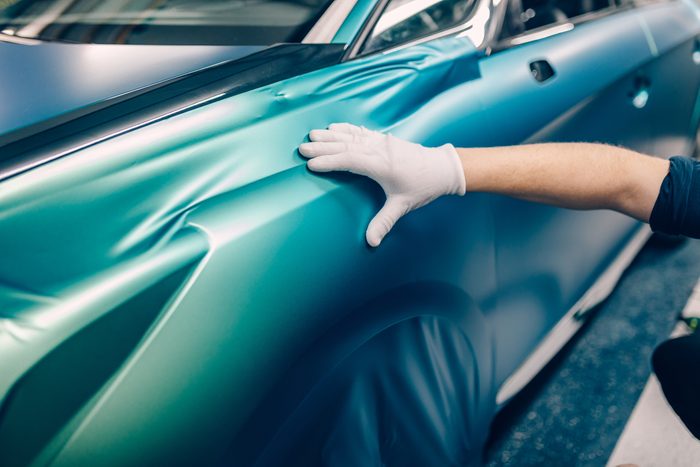How Much Does It Cost to Wrap a Car?

Wrapping a car costs less than spraying a new finish, but it won't last as long. It's like clothing for your car that you can change periodically.
My first car was a 1964 Volkswagen Beetle. Because it was inexpensive and there was little to lose, I decided to exercise my creativity and paint it myself. It took about two months for the paint to start peeling, and for me to understand the value of durable auto finishes applied with a spray gun.
These days, a wrap is an even better option for updating your car’s appearance. It’s durable and actually helps protect the body from chips, dents and minor damage. And a wrap isn’t permanent. When you tire of the look, simply peel off the wrap and restore the original appearance.
Even if wrapping had been an option for my Beetle, I couldn’t do it do myself because I lacked the tools and expertise. I also didn’t have $2,000, the current minimum for wrapping a car. For someone seeking a fresh look for a car in reasonably good shape, a wrap can be a great investment.
On This Page
What Is a Car Wrap?
A car wrap consists of large vinyl decals custom-cut to cover various parts of a car, including the hood, fenders, side panels, door and roof.
Wraps must to be ordered to be sure they fit your specific vehicle. The decals are applied like shrink-wrap — draped over the car part, then “welded” to the surface with a heat gun and special solvent. It remove, just peel it off with a heat gun. It shouldn’t harm the finish underneath.
Transparent wraps protect the existing finish. They’re often installed on high-end cars by their owners, and on leased cars by the leasing company. Wraps also change a car’s appearance. The wrap can be opaque or display advertising, and it doesn’t always cover the whole vehicle. You can apply a partial wrap to the hood, the doors or any other part.
Car Wrap Cost Considerations
Not every vehicle is a good candidate for a wrap. It won’t hide dings, dents and holes, but these can be corrected before applying the wrap. More serious obstacles include chipping or flaking paint and oxidation. These give the finish a whitish, powdery appearance and prevent the vinyl from adhering.
If a vehicle is in good enough condition for a wrap, the main cost considerations are its make and model. Other factors that influence cost include:
- The amount of bodywork necessary to make the car good enough to wrap.
- Extra work required to apply the wrap, like removing the bumpers, headlights and taillights. This is more difficult for some cars than others.
- The quality of the wrap. A textured or metallic wrap usually costs more than a transparent one, and wraps with special designs or advertising are more expensive than monochromatic ones.
How Much Is It To Wrap a Car?
The cost varies widely. The vinyl itself costs from $5 to $15 per square foot, and installation generally runs from $3 to $4 per square foot. Labor costs for vehicles in poor condition or difficult to disassemble can be much higher.
For a compact or subcompact in good condition, the minimum is around $2,000. For other types of vehicles, the following quotes are typical:
- Family sedan, small SUV, coupe: $2,000 to $3,000.
- Full-sized SUV, van: $3,500 to $4,000.
- Truck: $2,000 to $5,000, depending on size.
- Commercial vehicle: $3,000 to $5,000.
- Luxury car: $5,000 to $10,000.
Partial wraps can cost as little as $500 to $1,000.
How Long Does a Car Wrap Last?
Three to seven years. To achieve a long life, park the car in a covered space to protect it from the sun, and wash it after driving in snowy conditions to remove salt. When the time comes to remove the wrap, you can do the job yourself with a heat gun. Professional removal will cost about $500.
Can I DIY Car Wrap?
Yes. Like spraying paint, car wrapping needs to be done indoors, but the process generates no over-spray or toxic fumes.
To DIY, you’ll need tools like special cutters, squeegees and a heat gun, so you might not save as much money as you think. You’ll need a lot of patience, too, because preparing the finish and wrapping are painstaking jobs. Plus, small mistakes are hard to fix.
Partial wrapping, perhaps to display a company logo or add color, is a much more DIY-able project.



